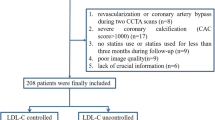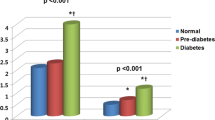Abstract
Introduction
More and more evidence suggests that the density of calcification plays an important role in the plaque stability. However, few studies have investigated the statin treatment on the density of plaque calcification in patients with both coronary artery disease (CAD) and type 2 diabetes mellitus.
Methods
One hundred and twenty-two CAD patients with type 2 diabetes with confirmed coronary artery calcification (CAC) will be recruited consecutively in a 12-month period. These patients will receive rosuvastatin (20 mg/day) therapy in the next 24 months. Blood tests and adverse events will be collected at routine follow-up of 1, 3, 6, 12, 18 and 24 months. The primary endpoint will be the change of CAC density score measured by coronary CT angiography after 24 months’ treatment of rosuvastatin (20 mg/day) compared with baseline. The secondary endpoints will be the change of serum sclerostin and the effect on the volume score of CAC in those patients.
Results
We expect that rosuvastatin could both increase the density of CAC to improve plaque stability and up-regulate serum sclerostin, which would suggest the underlying mechanism of the plaque stabilization by a statin.
Conclusion
This study would be the first to demonstrate the impact of rosuvastatin on the density score of coronary artery calcification in CAD patients with type 2 diabetes.
This study has been registered in ClinicalTrials.gov (NCT02418884).

Similar content being viewed by others
References
Pugliese G, Iacobini C, Fantauzzi CB, Menini S. The dark and bright side of atherosclerotic calcification. Atherosclerosis. 2015;238:220–30.
Daga N, Nasir K, Hamirani Y, Tayek J, Bach P, Li D, et al. Prevalence and severity of coronary artery calcium in young persons with diabetes. J Cardiovasc Comput Tomogr. 2013;7:241–7.
Katz R, Budoff MJ, O’Brien KD, Wong ND, Nasir K. The metabolic syndrome and diabetes mellitus as predictors of thoracic aortic calcification as detected by non-contrast computed tomography in the multi-ethnic study of atherosclerosis. Diabet Med. 2015;33:912–9. doi:10.1111/dme.12958.
Ruiz JL, Hutcheson JD, Aikawa E. Cardiovascular calcification: Current controversies and novel concepts. Cardiovasc Pathol. 2015;24:207–12.
Mizukoshi M, Kubo T, Takarada S, Kitabata H, Ino Y, Tanimoto T, et al. Coronary superficial and spotty calcium deposits in culprit coronary lesions of acute coronary syndrome as determined by optical coherence tomography. Am J Cardiol. 2013;112:34–40.
Vazquez-Figueroa JG, Rinehart S, Qian Z, Joshi PH, Sharma A, Lee J, et al. Prospective validation that vulnerable plaque associated with major adverse outcomes have larger plaque volume, less dense calcium, and more non-calcified plaque by quantitative, three-dimensional measurements using intravascular ultrasound with radiofrequency backscatter analysis: results from the atlanta i study. J Cardiovasc Transl Res. 2013;6:762–71.
Pu J, Mintz GS, Biro S, Lee JB, Sum ST, Madden SP, et al. Insights into echo-attenuated plaques, echolucent plaques, and plaques with spotty calcification: novel findings from comparisons among intravascular ultrasound, near-infrared spectroscopy, and pathological histology in 2,294 human coronary artery segments. J Am Coll Cardiol. 2014;63:2220–33.
Leber AW, Knez A, White CW, Becker A, von Ziegler F, Muehling O, et al. Composition of coronary atherosclerotic plaques in patients with acute myocardial infarction and stable angina pectoris determined by contrast-enhanced multislice computed tomography. Am J Cardiol. 2003;91:714–8.
Shemesh J, Apter S, Itzchak Y, Motro M. Coronary calcification compared in patients with acute versus in those with chronic coronary events by using dual-sector spiral CT. Radiology. 2003;226:483–8.
Ehara S, Kobayashi Y, Yoshiyama M, Shimada K, Shimada Y, Fukuda D, et al. Spotty calcification typifies the culprit plaque in patients with acute myocardial infarction: an intravascular ultrasound study. Circulation. 2004;110:3424–9.
Criqui MH, Denenberg JO, Ix JH, McClelland RL, Wassel CL, Rifkin DE, et al. Calcium density of coronary artery plaque and risk of incident cardiovascular events. JAMA. 2014;311:271–8.
Houslay ES, Cowell SJ, Prescott RJ, Reid J, Burton J, Northridge DB, et al. Progressive coronary calcification despite intensive lipid-lowering treatment: a randomised controlled trial. Heart. 2006;92:1207–12.
Terry JG, Carr JJ, Kouba EO, Davis DH, Menon L, Bender K, et al. Effect of simvastatin (80 mg) on coronary and abdominal aortic arterial calcium (from the coronary artery calcification treatment with zocor [CATZ] study). Am J Cardiol. 2007;99:1714–7.
Henein M, Granåsen G, Wiklund U, Schmermund A, Guerci A, Erbel R, et al. High dose and long-term statin therapy accelerate coronary artery calcification. Int J Cardiol. 2015;184:581–6.
Saremi A, Bahn G, Reaven PD, for the VADT Investigators. Progression of vascular calcification is increased with statin use in the veterans affairs diabetes trial (VADT). Diabetes Care. 2012;35:2390–2.
Kitagawa T, Yamamoto H, Horiguchi J, Ohashi N, Kunita E, Utsunomiya H, et al. Effects of statin therapy on non-calcified coronary plaque assessed by 64-slice computed tomography. Int J Cardiol. 2011;150:146–50.
García-Martín A, Rozas-Moreno P, Reyes-García R, Morales-Santana S, García-Fontana B, García-Salcedo JA, et al. Circulating levels of sclerostin are increased in patients with type 2 diabetes mellitus. J Clin Endocrinol Metab. 2012;97:234–41.
Koos R, Brandenburg V, Mahnken AH, Schneider R, Dohmen G, Autschbach R, et al. Sclerostin as a potential novel biomarker for aortic valve calcification: an in vivo and ex vivo study. J Heart Valve Dis. 2013;22:317–25.
Brandenburg VM, Kramann R, Koos R, Krüger T, Schurgers L, Mühlenbruch G, et al. Relationship between sclerostin and cardiovascular calcification in hemodialysis patients: a cross-sectional study. BMC Nephrol. 2013;14:219.
Morales-Santana S, García-Fontana B, García-Martín A, Rozas-Moreno P, García-Salcedo JA, Reyes-García R, et al. Atherosclerotic disease in type 2 diabetes is associated with an increase in sclerostin levels. Diabetes Care. 2013;36:1667–74.
Expert Panel on Detection. Evaluation, and treatment of high blood cholesterol in adults. Executive summary of the third report of the national cholesterol education program (NCEP) expert panel on detection, evaluation, and treatment of high blood cholesterol in adults (adult treatment panel III). JAMA. 2001;285:2486–97.
Schmermund A, Achenbach S, Budde T, Buziashvili Y, Förster A, Friedrich G, et al. Effect of intensive versus standard lipid-lowering treatment with atorvastatin on the progression of calcified coronary atherosclerosis over 12 months: a multicenter, randomized, double-blind trial. Circulation. 2006;113:427–37.
Stone NJ, Robinson JG, Lichtenstein AH, Bairey Merz CN, Blum CB, Eckel RH, et al. 2013 ACC/AHA guideline on the treatment of blood cholesterol to reduce atherosclerotic cardiovascular risk in adults: a report of the American College of Cardiology/American Heart Association Task Force on Practice Guidelines. Circulation. 2014;129(Suppl 2):S1–45.
American Diabetes Association. Standards of Medical Care in Diabetes-2016, Sec. 8 cardiovascular disease and risk management. Diabetes Care. 2016;39(Suppl 1):S60–71.
Takayama T, Hiro T, Yamagishi M, Daida H, Hirayama A, Saito S, et al. Effect of rosuvastatin on coronary atheroma in stable coronary artery disease: multicenter coronary atherosclerosis study measuring effects of rosuvastatin using intravascular ultrasound in Japanese subjects (COSMOS). Circ J. 2009;73:2110–7.
Saito Y, Yamada N, Shirai K, Sasaki J, Ebihara Y, Yanase T, et al. Effect of rosuvastatin 5–20 mg on triglycerides and other lipid parameters in Japanese patients with hypertriglyceridemia. Atherosclerosis. 2007;194:505–11.
Kim SR, Lee SS, Yoo SJ, Kang SK. The efficacy and safety of rosuvastatin therapy in Korean dyslipidemic type 2 diabetes mellitus patients who can not reach the LDL cholesterol target at initial dosage of another LDL lowering agents. 20th World Diabetes Congress of the International Diabetes Federation (IDF), Montreal, Canada, 2009.
Acknowledgments
This study was supported by Natural Science Foundation of Zhejiang Province (No. LQ14H020002), Health Department Foundation of Zhejiang Province (No. 201466184), Natural Science Foundation of Zhejiang Province (No. LQ16H020002), National Natural Science Foundation of China (No. 81500212) and AstraZeneca (No. ESR-14-10098).
Author information
Authors and Affiliations
Corresponding authors
Ethics declarations
Conflict of interest
Wenbin Zhang, Yi Luan, Chongying Jin, Shengjie Xu, Xukun Bi, Yanbo Zhao, Fuyu Qiu, Guosheng Fu and Min Wang have no conflict of interest.
Ethical approval
Approval of the protocols and informed consent forms were obtained from the institutional ethics committee of Sir Run Run Shaw Hospital of Zhejiang University and Zhejiang Hospital, and written informed consents were obtained from all patients. This study has been registered in ClinicalTrials.gov (NCT02418884).
Additional information
W. Zhang and Y. Luan contributed equally to this work.
Rights and permissions
About this article
Cite this article
Zhang, W., Luan, Y., Jin, C. et al. The Impact of Rosuvastatin on the Density Score of Coronary Artery Calcification in Coronary Artery Disease Patients with Type 2 Diabetes Mellitus: Rationale and Design of RosCal Study. Clin Drug Investig 36, 1023–1029 (2016). https://doi.org/10.1007/s40261-016-0445-4
Published:
Issue Date:
DOI: https://doi.org/10.1007/s40261-016-0445-4




